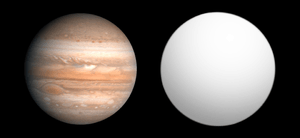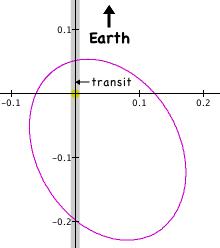HD 17156 b
| Exoplanet | List of exoplanets | |
|---|---|---|
 | ||
| Parent star | ||
| Star | HD 17156 | |
| Constellation | Cassiopeia | |
| Right ascension | (α) | 02h 49m 44.49s[1] |
| Declination | (δ) | +71° 45′ 11.6″[1] |
| Apparent magnitude | (mV) | 8.17[2] |
| Distance | 245 ± 13[1] ly (75 ± 4[1] pc) | |
| Spectral type | G0[3] | |
| Mass | (m) | 1.275 ± 0.018[4] M☉ |
| Radius | (r) | 1.5007 ± 0.0076[4] R☉ |
| Temperature | (T) | 6079 ± 80 K |
| Metallicity | [Fe/H] | 0.24 ± 0.05 |
| Age | 3.38+0.20 −0.47[4] Gyr | |
| Orbital elements | ||
| Semi-major axis | (a) | 0.1589[5] AU |
| Eccentricity | (e) | 0.6768 ± 0.0034[4] |
| Orbital period | (P) | 21.2163979 ± 0.0000159[4] d |
| Inclination | (i) | 86.573 ± 0.060[4]° |
| Argument of periastron |
(ω) | 121.71 ± 0.43[4]° |
| Time of periastron | (T0) | 2454438.4835±0.0025[5] JD |
| Semi-amplitude | (K) | 274.2 ± 2.0[4] m/s |
| Physical characteristics | ||
| Mass | (m) | 3.191 ± 0.033[4] MJ |
| Radius | (r) | 1.0870 ± 0.0066[4] RJ |
| Density | (ρ) | 3470[5] kg m−3 |
| Surface gravity | (g) | 67.0 ± 2.4[4] m/s² |
| Temperature | (T) | ? |
| Discovery information | ||
| Discovery date | 14 April 2007 | |
| Discoverer(s) | Fischer et al.[3] | |
| Discovery method | Radial velocity and Transit | |
| Discovery site | W. M. Keck Observatory Subaru Telescope | |
| Discovery status | Published[3] | |
| Database references | ||
| Extrasolar Planets Encyclopaedia | data | |
| SIMBAD | data | |
| Exoplanet Archive | data | |
| Open Exoplanet Catalogue | data | |
HD 17156 b is an extrasolar planet approximately 240 light-years away[1] in the constellation of Cassiopeia. The planet was discovered orbiting the yellow subgiant star HD 17156 in April 2007. The planet is classified as a relatively cool hot Jupiter planet slightly smaller than Jupiter but slightly larger than Saturn in a so-called "torched orbit". This highly-eccentric three-week orbit takes it approximately 0.0523 AU of the star at periastron before swinging out to approximately 0.2665 AU at apastron. Its eccentricity is about the same as 16 Cygni Bb, a so-called "eccentric Jupiter". Until 2009, HD 17156 b was the transiting planet with the longest orbital period.[6]

The planet was discovered on April 14, 2007 by a team using the radial velocity method on the Keck and Subaru telescopes.[3] The team made an initial, negative, transit search, but they were only able to cover 25% of the search space. This left the possibility of a transit open.
After the possibility of a transit was discussed on oklo.org, various groups performed a follow-on search. These searches confirmed a three-hour transit on October 2, 2007 and a paper was published two days later.[7]
Careful radial velocity measurements have made it possible to detect the Rossiter–McLaughlin effect, the shifting in photospheric spectral lines caused by the planet occulting a part of the rotating stellar surface. This effect allows the measurement of the angle between the planet's orbital plane and the equatorial plane of the star. This planet's spin-orbit angle was initially measured by Narita in 2007 as +62 ± 25 but has been remeasured by Cochran +9.4 ± 9.3 degrees.[8] By analogy with HD 149026 b, a low angle would imply the formation of the planet was peaceful and probably involved interactions with the protoplanetary disc. A much larger angle suggests a violent interplay with other protoplanets. Given its eccentricity the latter is equally probable until the discrepancy of the Rossiter results is resolved.
It is so distant from its star and eccentric, that it will never enter a secondary eclipse relative to Earth, of the planet behind the star.[5][9] The star's true temperature, and so the planet's surface temperature, cannot be measured with accuracy. Due to the high eccentricity the atmosphere of the planet undergoes a factor of 27 variation in stellar flux during each orbit.[10]
See also
References
- 1 2 3 4 5 van Leeuwen, F. (2007). "Validation of the new Hipparcos reduction". Astronomy and Astrophysics. 474 (2): 653–664. arXiv:0708.1752
 . Bibcode:2007A&A...474..653V. doi:10.1051/0004-6361:20078357. Vizier catalog entry
. Bibcode:2007A&A...474..653V. doi:10.1051/0004-6361:20078357. Vizier catalog entry - ↑ "SIMBAD query result: HIP 13192 -- Star". Centre de Données astronomiques de Strasbourg. Retrieved 2009-05-20.
- 1 2 3 4 Fischer, Debra A.; et al. (2007). "Five Intermediate-Period Planets from the N2K Sample". The Astrophysical Journal. 669 (2): 1336–1344. arXiv:0704.1191
 . Bibcode:2007ApJ...669.1336F. doi:10.1086/521869.
. Bibcode:2007ApJ...669.1336F. doi:10.1086/521869. - 1 2 3 4 5 6 7 8 9 10 11 Nutzman, Philip; et al. (2011). "Precise Estimates of the Physical Parameters for the Exoplanet System HD 17156 Enabled by Hubble Space Telescope Fine Guidance Sensor Transit and Asteroseismic Observations". The Astrophysical Journal. 726 (1). article number 3. arXiv:1011.0440
 . Bibcode:2011ApJ...726....3N. doi:10.1088/0004-637X/726/1/3.
. Bibcode:2011ApJ...726....3N. doi:10.1088/0004-637X/726/1/3. - 1 2 3 4 Gillon, M.; Triaud, A. H. M. J.; Mayor, M.; Queloz, D.; Udry, S.; North, P. (2007). "Improved parameters for the transiting planet HD 17156b: A high-density giant planet with a very eccentric orbit". Astronomy and Astrophysics. 485 (3): 871–875. arXiv:0712.2073
 . Bibcode:2008A&A...485..871G. doi:10.1051/0004-6361:20079238.
. Bibcode:2008A&A...485..871G. doi:10.1051/0004-6361:20079238. - ↑ TransitSearch (See: HD 80606 b)
- ↑ Barbieri, M.; et al. (2007). "HD 17156b: A Transiting Planet with a 21.2 Day Period and an Eccentric Orbit". Astronomy and Astrophysics Letters. 476 (2): L13–L16. arXiv:0710.0898
 . Bibcode:2007A&A...476L..13B. doi:10.1051/0004-6361:20078787.
. Bibcode:2007A&A...476L..13B. doi:10.1051/0004-6361:20078787. - ↑ Cochran, W. D., Redfield, S., Endl, M., & Cochran (10 August 2008). "The Spin-Orbit Alignment of the HD 17156 Transiting Eccentric Planetary System". The Astrophysical Journal Letters. 683: L59–L62. arXiv:0806.4142
 . Bibcode:2008ApJ...683L..59C. doi:10.1086/591317.
. Bibcode:2008ApJ...683L..59C. doi:10.1086/591317. - ↑ Jonathan Irwin; David Charbonneau; Philip Nutzman (July 2008). "Parameters and Predictions for the Long-Period Transiting Planet HD 17156b". The Astrophysical Journal. 681: 636–643. arXiv:0801.1496
 . Bibcode:2008ApJ...681..636I. doi:10.1086/588461.
. Bibcode:2008ApJ...681..636I. doi:10.1086/588461. - ↑ Koskinen, T. T.; et al. (2009). "The Upper Atmosphere of HD17156b". The Astrophysical Journal. 693 (1): 868–885. arXiv:0811.4751
 . Bibcode:2009ApJ...693..868K. doi:10.1088/0004-637X/693/1/868.
. Bibcode:2009ApJ...693..868K. doi:10.1088/0004-637X/693/1/868.
External links
![]() Media related to HD 17156 b at Wikimedia Commons
Media related to HD 17156 b at Wikimedia Commons
Coordinates: ![]() 02h 49m 44.49s, +71° 45′ 11.64″
02h 49m 44.49s, +71° 45′ 11.64″